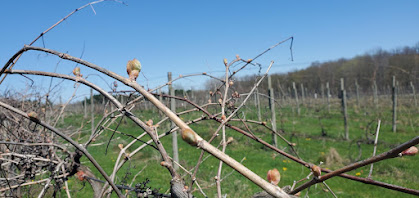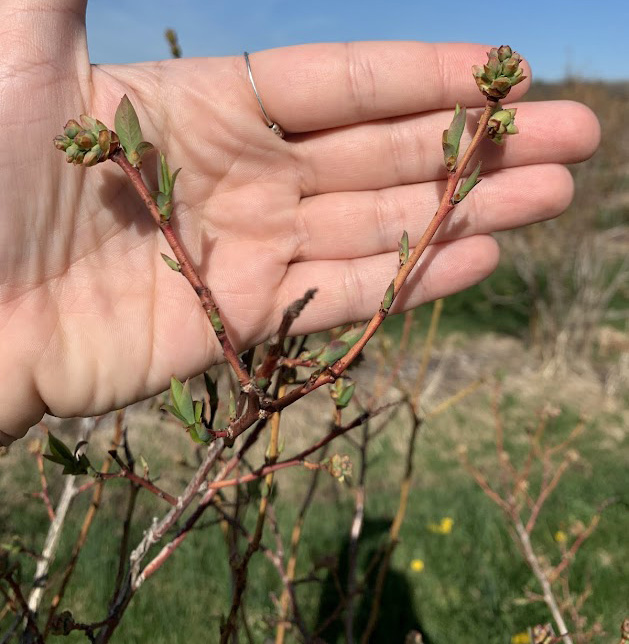Southwest Michigan fruit update – April 16, 2024
Fruit crops are developing rapidly in southwest Michigan.

The week started out fairly warm in the low 70s. This warm weather has helped move along crop phenology. As the week progresses, there is a likelihood of scattered showers or thunderstorms, particularly towards the middle and end of the week. These showers mean there are chances for disease infections, so keep an eye on the weather as the week ends. Depending on how the showers develop, there is also the potential for more severe weather including high winds. These storms could bring slightly cooler temperatures along with precipitation, with the lowest temperatures predicted for Sunday night, April 21, into Monday morning.
Watch the latest weather report from Michigan State University meteorologist Jeff Andresen.
|
Southwest Michigan growing degree day (GDD) summary from March 1 – April 15, 2024 |
|||
|---|---|---|---|
|
Station |
GDD 42 F |
GDD 45 F |
GDD 50 F |
|
Benton Harbor (SWMREC) |
267 |
199 |
118 |
|
Lawton (Lawton) |
263 |
197 |
116 |
|
Fennville (TNRC) |
218 |
157 |
85 |
|
Grand Junction |
258 |
192 |
111 |
|
Average for the SW region |
255 |
190 |
110 |
Tree fruit
Warmer temperatures over the weekend have pushed all tree fruit into bloom with increased bee activity.
Apricots are still in petal fall with fruit starting to swell in the shuck in central Berrien County. Brown rot infections are favored by wet conditions and temperatures over 50 degrees Fahrenheit during bloom.
Peach and nectarine are at mid-bloom in Berrien County and early bloom in Allegan County. With bloom, potential peach crops look better than originally estimated for some farms in northwest Berrien County near the Allegan County line.
The Trevor Nichols Research Center in Fennville, Michigan, reported first catch this week of oriental fruit moth adults in their trapline. The estimated biofix using GDD base 45 F for oriental fruit moth activity (starting March 1) is 175 GDD for first adult emergence (biofix 1). This would put estimated biofix 1 for central Berrien County at April 12. Control is recommended at approximately 100-150 GDD base 45 F after biofix 1 for selective products with ovicidal activity or 170-195 GDD (10-15% of egg hatch) for organophosphates, carbamates and pyrethroids (check product) from the biofix date. Daily GDD base 45 is currently ranging from 5 on cool days to 20 on warm days. Pheromone disruption for first generation flight, if wanted, should be installed in the next day or two.
Cherry bloom has moved quickly with sweet cherries at early petal fall and tart cherries at full bloom. Bract leaves have unfolded in tart cherries, which means that stomates are mature enough for infection by cherry leaf spot in central Berrien County. Cherry leaf susceptibility for central Berrien County is April 8 (250 GDD base 42 after Jan. 1). Brown rot can occur under a wide range of temperatures (40 to 86 F), but optimal temperature is 64 to 78 F, with 4-plus hours of wet conditions.
In plums, Shiro Japanese plum fruit buds are at petal fall and Stanley European plum moved from tight cluster last week to full bloom over the past weekend in Berrien County. Critical time for fungicide control for black knot is petal fall (usually mid- to late May) to late June (10-inch new shoot growth). Fungicide treatment must be combined with thorough pruning to remove knots. Like other stone fruit, brown rot infections are favored by temperatures in the 60s and 70s with rain.
Apple early variety Zestar is at pink to early king bloom and most other varieties are at pink in Berrien County. Retain (AVG) applications can help extend flower viability if cool conditions during bloom delay fertilization. Promalin treatment is another option to help preserve fruit production if borderline freeze conditions occur during bloom cause slight damage to flowers. Apple scab ascospores continue to be caught in good numbers in area traps. Powdery mildew treatment begins at tight cluster for susceptible varieties, and juniper rust treatment at pink for orchards with junipers and cedars nearby.
Pear (Bartlett) fruit buds are at popcorn (blossoms not quite open) with Harrow Sweet slightly behind in Berrien County. Continued scab sprays are needed to protect green tissue against infection. Fire blight management is needed for susceptible varieties when temperatures above 70 F and rain occurs during bloom. Fire blight resistance to streptomycin is widespread throughout most of the western Michigan apple and pear growing regions.
Small fruit
Grape budbreak is underway. Early hybrids like Marquette are showing green tissue. Open leaves are expected this week. Other hybrids are between late bud swell and early leaf opening. Juice grapes are in late bud swell as well. Pruning for the spring should be finishing up. For growers looking to delay budbreak, some research indicates oils such as Amigo sprayed on dormant buds can delay budbreak for a few days, but delayed pruning seems to have more consistent results. Grapes break bud near the upper portions of the canes first. By waiting until frosts are finished before final pruning, the early buds that will be pruned off anyway will get damaged. Once those canes are removed, the retained buds will open later.

In blueberries, with the warm weather last week and this week, blueberries are at early pink bud in southern Berrien County with Pawpaw, Michigan, up through Fennville being at the end of tight cluster. It’s supposed to be warm through the beginning of this week and plants are expected to move quickly. Green tissue was observed up through Fennville, which means the window to apply dormant sprays like Sulforix or lime sulfur products to suppress early season diseases is nearly closed.
Want more blueberry specific content? Subscribe to Blueberry Bites!

Strawberry flower trusses are beginning to emerge. Remember, critical temperatures for strawberries are 10 F when they’re in the ground and 20 F when they’re out of the ground. Keep an eye on the phenology of your strawberries with the potential for cold weather this weekend.
Growers are looking at early season herbicides to control overwintering weeds. When selecting an herbicide, check the preharvest interval (PHI). We are getting to the part of spring where some herbicide PHIs are cutting it close to predicted harvest dates.
Bramble leaves have begun emerging from both summer and fall bearing varieties. The window for applying dormant sprays is closing fast.
Upcoming meetings
Our weekly Monday Night South Michigan Fruit IPM Meetings will once again be a hybrid format. The meetings will be held in-person at the Southwest Michigan Research and Extension Center, 1791 Hillandale Rd, Benton Harbor, MI 49022, with virtual attendance available online. Our next meeting is Monday, April 22, at 5:30 p.m. No advanced signup is needed for attending in-person. The meetings are free, and one pesticide applicator credit is available for each meeting.
The MSU Extension blueberry team will be hosting a Blueberry Pollination Meeting on May 15 the Trevor Nichols Research Center in Fennville.
Additional information and surveys
Michigan State University is running a pollinator survey this spring and summer to understand how people interact with pollinators in natural, urban and managed landscapes. The survey is anonymous and takes only 10-15 minutes to complete.
This work is supported by the Crop Protection and Pest Management Program [grant no 2021-70006-35450] from the USDA National Institute of Food and Agriculture. Any opinions, findings, conclusions, or recommendations expressed in this publication are those of the author(s) and do not necessarily reflect the view of the U.S. Department of Agriculture.



 Print
Print Email
Email




